
Mastering WhatsApp Lead Generation: 6 Strategies for Boosting Sales and Conversions
Lead generation is the process of getting and engaging with potential customers to increase sales and conversions. It’s crucial for businesses to generate high-quality leads to drive revenue and growth. What makes lead generation important is that you as a business will always have customers coming and going away. But a good lead generation process will ensure you always have business coming in.
- Marketing Qualified Lead (MQL): These are contacts who have shown interest in a company’s marketing efforts, e.g. downloaded a white paper, attended a webinar or signed up for a newsletter. But they are not yet ready for direct sales outreach, as they are still in the early stages of the buying journey.
- Sales Qualified Lead (SQL): These are contacts who have taken specific actions that indicate they are ready to engage with the sales team. This could be requesting a demo, asking for pricing, or filling out a contact form with a specific question. SQLs are further along in the buying process and show clear intent to become paying customers.
- Product Qualified Lead (PQL): These leads have not only engaged with marketing efforts but have also used the company’s product in some way. This could be through a free trial, freemium version or limited time access offer. Their interaction with the product suggests a higher likelihood of conversion to paying customers, as they have had firsthand experience with the features and benefits.
- Service Qualified Lead: These are contacts or existing customers who have interacted with the company’s service team and expressed interest in upgrading or buying more services. This could be through support tickets, service calls or customer satisfaction surveys, indicating they have potential to increase their investment in the company’s offerings. Identify and Understand Your Target Audience
Building detailed profiles of your ideal customers is key to good marketing and lead gen. These profiles, called buyer personas, include demographics, behavior and preferences. By knowing who your customers are, what they need and how they interact with your product or service, you can tailor your marketing to meet their expectations. Use these buyer personas to create content that speaks directly to your audience’s interests and pain points. This targeted approach will increase engagement and make your lead gen more effective.
Understanding the stages of the buying cycle is key to creating content that resonates with your audience. The buying cycle has three stages: awareness, consideration and decision. During the awareness stage, potential customers recognize a problem or need. Content at this stage should educate and inform, help customers understand their issues and possible solutions. In the consideration stage, customers are evaluating different options to solve their needs. Content here should provide detailed information about your product or service, it’s benefits and how it stands out from the competition. Finally, in the decision stage, customers are ready to decide. Content should build trust and convince customers your product or service is the best choice. By creating content that addresses the specific needs and pain points of each stage, you can attract and engage your audience more effectively throughout their buying journey.
You can leverage the WhatsApp business platform to generate high-quality leads. With an estimated 2.79 billion unique users globally, WhatsApp is the most downloaded chat and messaging app worldwide.
WhatsApp also provides you with the WhatsApp business API, which is an official way for business to deliver compelling experiences at scale. Now we'll see how you can use WhatsApp as a lead generation tool to boost your online lead generation & sales process.
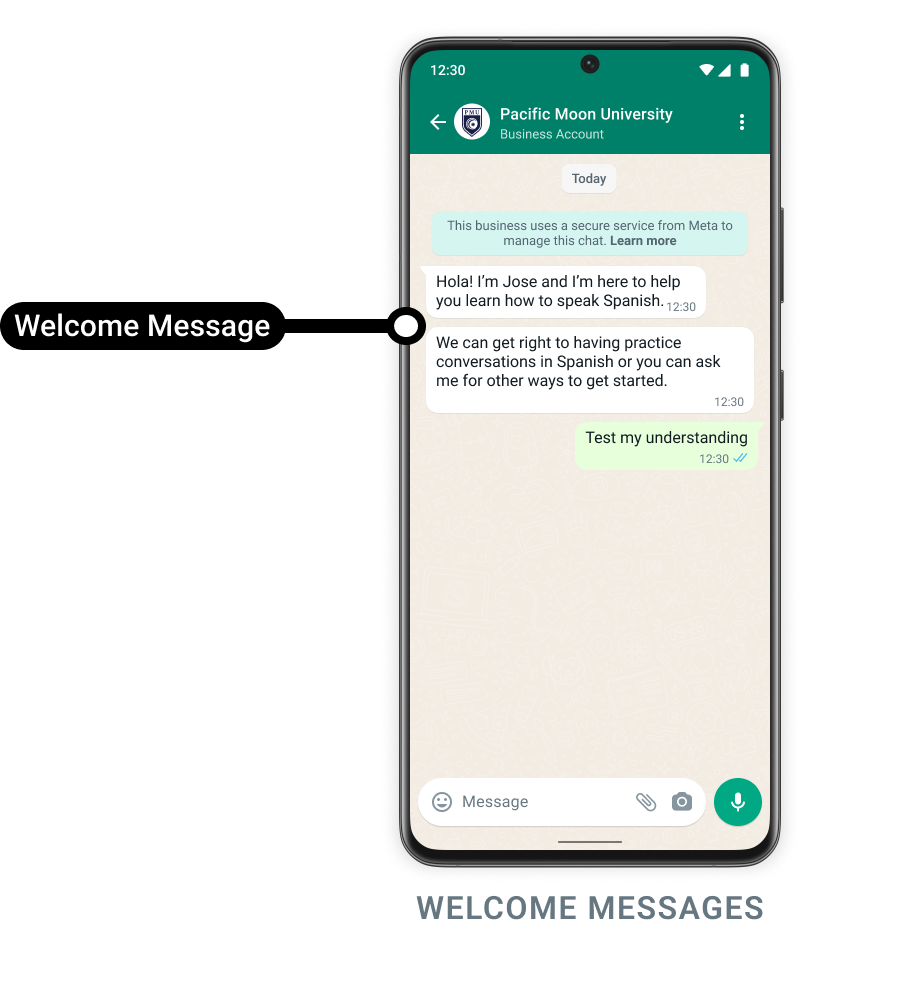
After you onboard onto the WhatsApp business platform, if you're using Spur as your Solution Provider. We provide an ability to send a welcome message to anyone who opens a chat with your number. This allows you to collect the lead even if they drop off and don't send a message. This lead generation plan brings in more prospective customers that you can nurture.
As soon as you set up your account on Spur, this flow is built by default for you, all you have to do is edit the copy & enable it!
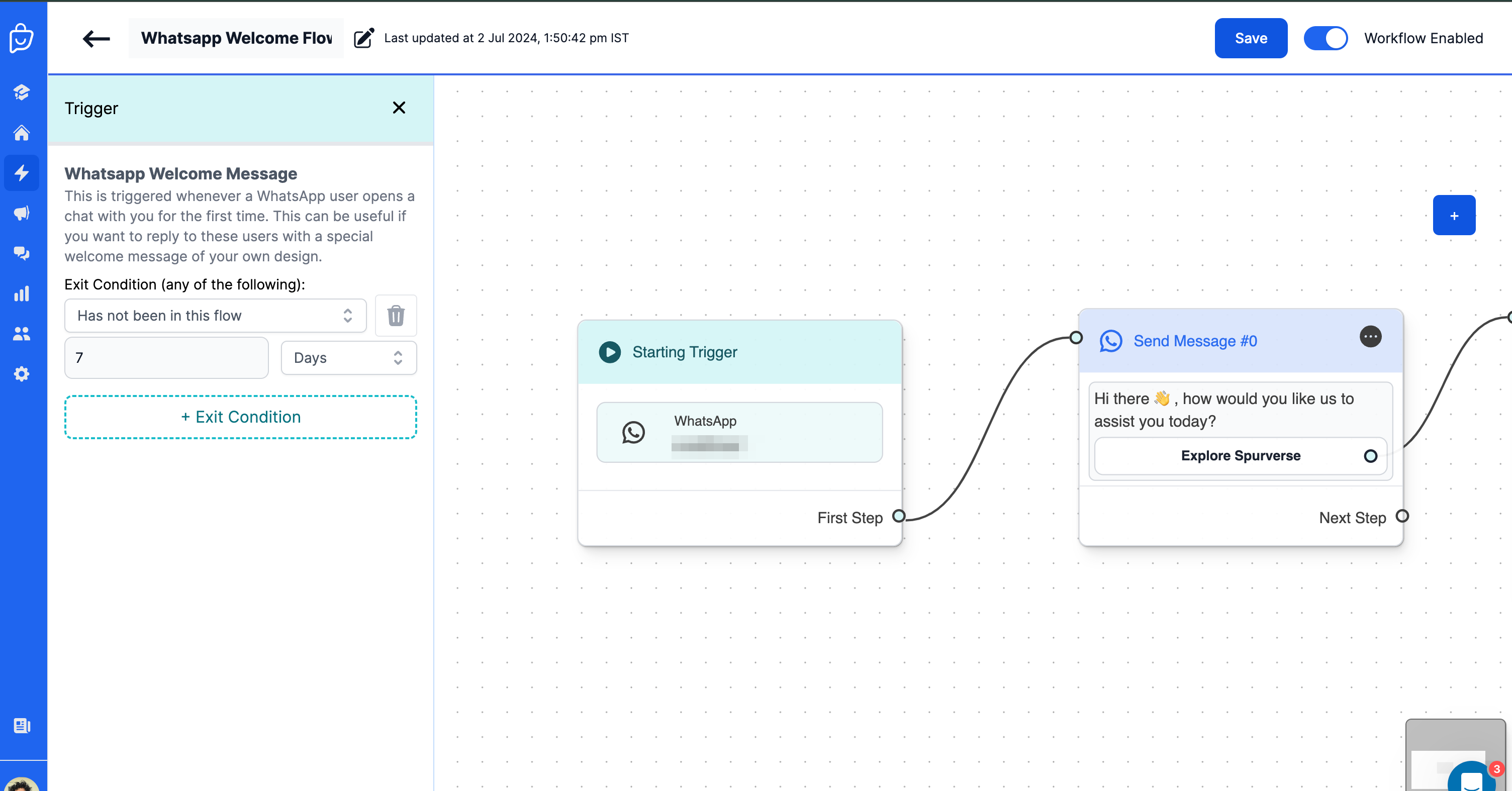
You can also track how many people entered this flow and easily export this contact list.
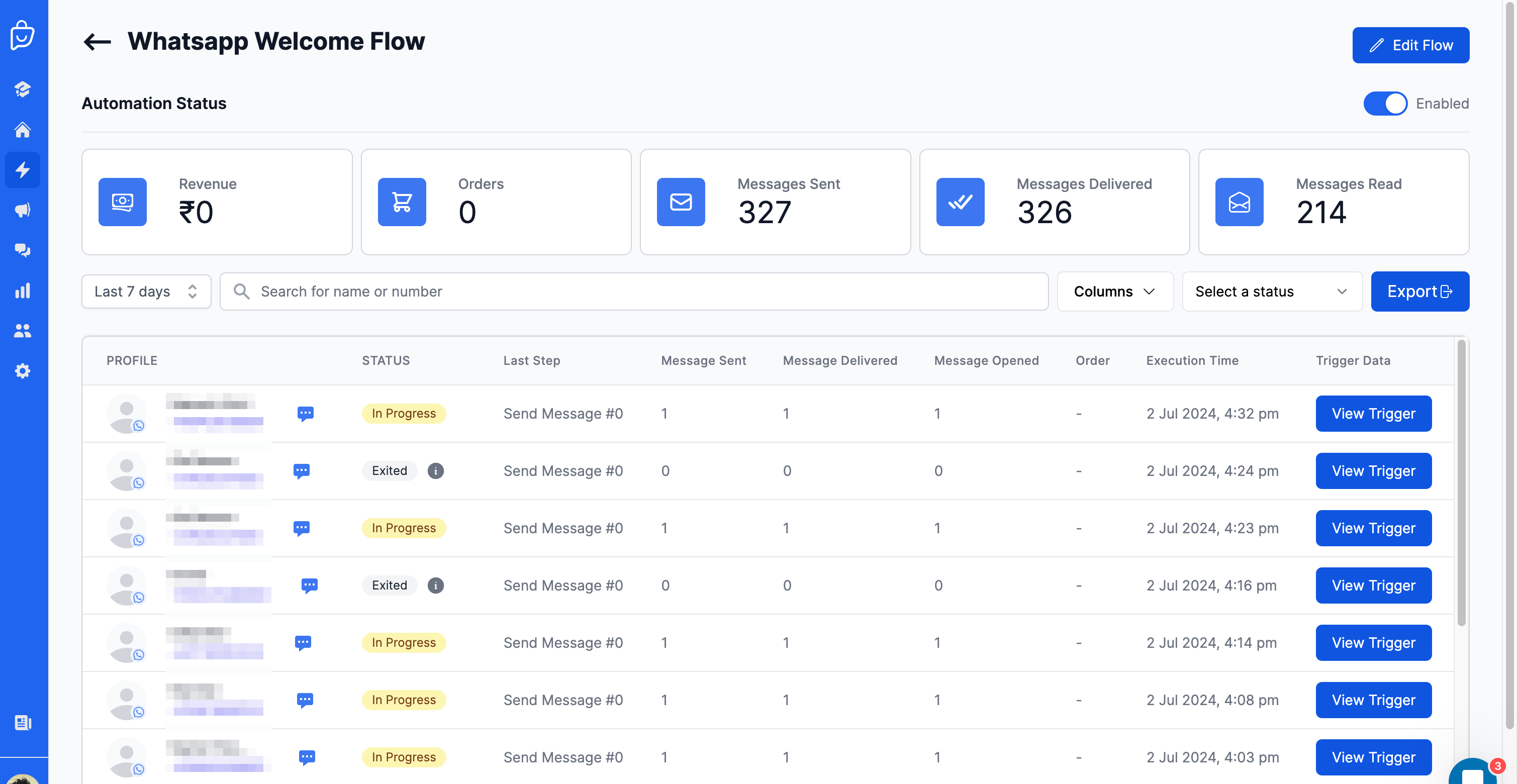
If you already have a Spur account and need help in setting it up. Head to our detailed guide here.

Click-to-WhatsApp ads are a great way to generate leads on social media. You can create a campaign on Facebook and Instagram with a call-to-action that sends the user to a WhatsApp chat with the business.
When the user clicks the ad, they are taken straight to a WhatsApp chat with the business. This makes it easy for the user to ask questions about a product or service. Click-to-WhatsApp ads can bring in qualified leads and conversions.
Example:
A local bakery runs a Click-to-WhatsApp ad on Instagram. The ad shows their new cupcake collection and has a "Message Us on WhatsApp" button. When users click this button, they are taken straight to a WhatsApp chat with the bakery. Here they can ask about flavors, place orders and ask about delivery options. This direct interaction makes the customer journey simpler and helps the bakery convert interested users into customers.
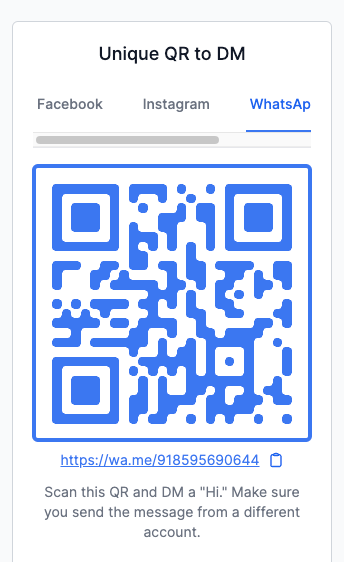
Leads and sales can be simplified with WhatsApp QR Codes. Creating a custom WhatsApp QR code is necessary to direct prospects to your WhatsApp Bot.
A good QR code should have commands to direct users to your WhatsApp Bot. Smart marketers attach images of products or services to this QR code.
When users scan the QR code, they are taken to a landing page to view the product or service being promoted. Some brands print ads with QR codes, so prospects can learn about the product and complete the purchase process via the WhatsApp Bot.
Example:
A fashion brand creates a WhatsApp QR code for their new collection. They put the QR code in their printed flyers and online ads which have images of the latest outfits. When users scan the QR code they are taken to a WhatsApp chat with the brand's bot where they can view the collection, ask questions and even place an order. This is a seamless way to attract and convert prospects.
To get started with WhatsApp QR Codes, you can get started with our Free WhatsApp QR Code Generator.
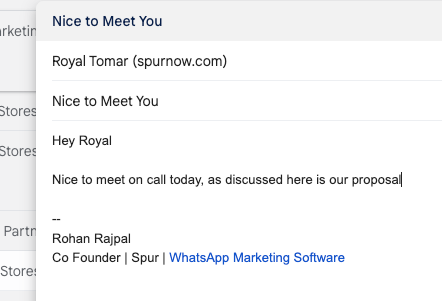
A great way to collect numbers is to include a wa.me link that you generate via the tool shared above in your email footer.
After your target audience clicks on the link, it opens your linked WhatsApp number, and then your sales team can take over. This allows you to leverage your existing email marketing campaigns to quickly generate leads without additional effort.
You have to use various lead generation tactics to generate qualified leads. WhatsApp is a great platform for lead qualification and streamlining your lead generation process. Here's how you do it
- Perform lead capture via website visitors on landing pages, WhatsApp chat widget or other lead generation marketing strategies
- Use lead generation tools like Spur to build a qualification chatbot and filter the lead based on your target audience
- Reduce your customer acquisition cost by retargeting quality leads on WhatsApp and reduce your sales cycle
Acquiring leads is hard, and converting them is even harder. The above inbound marketing strategy will drastically improve your lead conversion rate because of the sheer higher open rates of the WhatsApp platform.
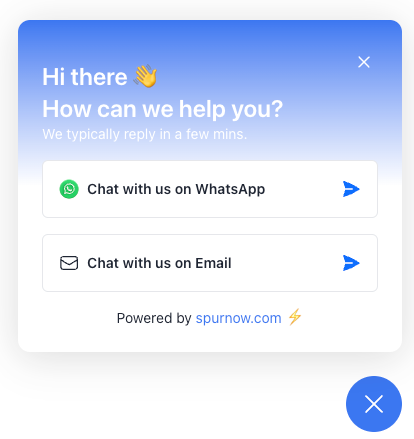
Add a chat widget for your website visitors to easily reach out and generate leads from landing pages, marketing and sales efforts. Additionally, existing customers can also use this widget to get any help with their solution, increasing customer satisfaction.
All top lead generation tools have a WhatsApp chat widget. Spur's chat widget has options for WhatsApp, Email, Instagram & Facebook. So that your potential leads have an option to reach out on their preferred social media platforms.
Lead generation is the lifeblood of any business looking to grow and succeed in today’s market. By having a solid lead generation strategy, you can attract and convert potential customers into buyers. This blog will cover all aspects of generating leads including inbound vs outbound leads, how to create successful lead generation strategies, tools, content marketing, search engine optimization SEO and paid advertising.
Inbound lead generation is about attracting potential customers through organic content, landing page, search engine optimization (SEO) and social media. This approach is about creating content that draws visitors to your website and gets them to engage with your brand. By providing valuable content you can build trust and position yourself as an expert in your industry. Key tactics for inbound lead generation include:
- Content Marketing: Publishing blog posts, ebooks, whitepapers and case studies that are relevant to your target audience.
- SEO: Optimizing website content to rank higher in search engine results, driving organic traffic.
- Social Media: Sharing valuable content on social media to engage with potential customers and drive traffic to your website.
- WhatsApp: Improve lead quality with qualification and follow-ups
Outbound lead generation is about proactively reaching out to potential customers through direct methods such as cold calling, emailing and social selling. This approach is about generating sales leads fast by identifying and contacting people who may be interested in your product or service. Key tactics for outbound lead include:
- Cold Calling: Reaching out to potential customers by phone to introduce your product or service.
- Email Campaigns: Sending targeted emails to prospects to nurture relationships and drive conversions.
- Social Selling: Using social media to connect with potential customers and build relationships.
- WhatsApp Campaigns: Sending targeted WhatsApp messages to potential clients and new leads
To create a successful lead generation strategy, you need to align your efforts with your business goals and target audience. Here are the key steps to creating an effective lead generation strategy:
- Define Your Goals: Clearly state what you want to achieve with your lead generation, e.g. increase website traffic, generate more leads or boost sales.
- Know Your Audience: Develop buyer personas to understand your target audience’s demographics, behavior and preferences.
- Combine Tactics: Use a mix of inbound and outbound tactics to generate quality leads. This approach assures a balanced strategy that leverages the strengths of both.
- Measure and Optimize: Continuously track your lead generation and adjust as needed to improve results.
No one single strategy will give you results, a combination of lead generation strategies will help in consistently generating business leads.
Having the right tools can supercharge your lead generation. Essential lead generation tools include:
- CRM Systems: Customer Relationship Management (CRM) systems to manage and analyse customer interactions so leads are properly nurtured and converted.
- Marketing Automation Software: These platforms automate repetitive marketing tasks such as email campaigns and social media posting so you can focus on strategy and creativity.
- Lead Scoring Platforms: These tools help score leads based on their likelihood to convert so sales teams can focus on the best prospects.
- Email Capture Forms: Put email capture forms on your website to capture contact information from visitors. Offer incentives such as free ebooks or discounts to encourage sign ups.
- Site Chat: Add live chat to your website to engage with prospective customers in real-time. This can help answer questions, provide support and capture leads more effectively.

Content that addresses the needs and pain points of each stage of the buying cycle is key to lead generation. This includes:
- Awareness Stage: Create content that educates potential customers about their problems and possible solutions, e.g. blog posts and infographics.
- Consideration Stage: Provide detailed information about your product or service through case studies, webinars and comparison guides.
- Decision Stage: Create content that helps potential customers make a final decision, e.g. product demos, free trials and customer testimonials.
Lead generation campaigns across these three stages on your landing pages and social media will bring in more leads & help you grow consistently.
Optimize your website content and structure for search engines, and you’ll see a big increase in visibility and organic traffic on your landing pages. Key SEO tactics for lead generation:
- Keyword Research: Find and target the keywords your potential customers are searching for & generate leads
- On-Page SEO: Optimize your website’s content, meta tags and internal linking structure for search engine rankings.
- Technical SEO: Make sure your website is fast, mobile-friendly and easy for search engines to crawl and index.
- Qualify leads: Use forms at various stages to reduce customer feedback loop and keep on improving your landing pages.

Social media platforms like Facebook and LinkedIn have powerful lead generation tools. Here are some strategies:
- Facebook Lead Ads: Create targeted ads that collect lead information within Facebook so users can sign up. You can also include questions to improve lead quality.
- LinkedIn Lead Gen Forms: Use LinkedIn’s lead gen forms to capture contact information from professionals and decision makers. Helps LinkedIn forms help generate leads directly.
Pay-per-click (PPC) advertising and B2B lead generation can drive targeted traffic and quality leads. Here are some tactics:
- PPC Advertising: Use platforms like Google Ads to run targeted ad campaigns that drive traffic to your website and capture leads.
- B2B Lead Generation: Target business decision makers with strategies such as account-based marketing (ABM) and LinkedIn outreach.
By using these strategies and the right tools you can have a complete lead generation strategy that attracts, engages and converts potential customers and drives growth and success.
To qualify and nurture leads you need to measure their interest and buying readiness. Lead scoring is a way to quantify this by assigning numbers to the actions a lead takes. By building a lead scoring system you can identify good leads and prioritise follow up. So sales teams can focus on the best prospects and increase conversion rates and sales productivity.
Qualifying leads can be done in a 3-step process: identify, engage, nurture. First identify potential leads through inbound and outbound tactics. Next engage those leads with targeted content and interactions. Finally nurture the leads by providing continuous value and addressing their needs until they are ready to buy. And don’t forget to have a marketing-sales feedback loop. This loop ensures marketing and sales are aligned, improves lead quality and leads to a collaborative approach to lead gen.
Lead gen campaigns are data driven. By following the data you can see trends, areas to improve and what works. Using the right lead gen tools such as CRM, marketing automation and analytics platforms makes lead gen more efficient. These tools help you manage and nurture leads and get better results.
Offers for all stages of the buying cycle are key to attracting, engaging and nurturing leads. Create valuable offers such as free trials, discounts and exclusive content for the awareness, consideration and decision stages. These offers should provide value to potential customers and move them further down the sales funnel.
Consistency of message across all marketing channels and lead gen activity is important for building trust and credibility. Make sure your brand voice and message is the same across all comms. And deliver on your promises to leads to build trust and long-term relationships. Reliable and honest interactions with potential customers can have a big impact on conversion rates and customer loyalty.
Tracking key metrics is key to measuring lead gen. Focus on conversion rates, lead quality and sales pipeline growth. Analyse those metrics to see what’s working and what’s not. Use that data to optimize lead gen and overall performance.
Stay up to date with the latest lead gen stats and trends to improve. Review industry reports, case studies and best practices regularly to find new opportunities and new tactics. By using current data and trends, you can refine your lead gen and get better results.
The first step to mastering lead gen is to have a lead gen strategy that aligns with your business goals and target market. Measure, optimize and improve and drive revenue and growth. Use a mix of inbound and outbound tactics, the right tools and valuable content to attract, engage and convert quality leads and win long term.
